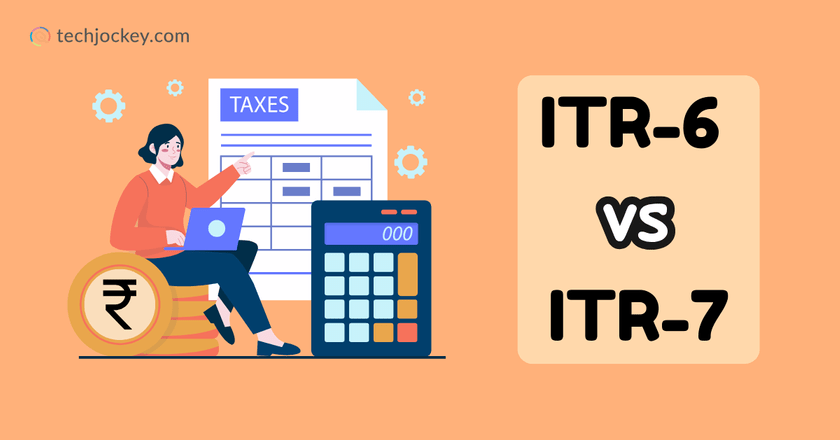ITR-6 vs ITR-7 – Filing Rules, Eligibility & Major Differences

Not only is filing ITR on time essential, but choosing the right type of ITR form is also important. Not all ITR forms are fit for everyone!
Different taxpayers have to file different categories of ITR forms. Wrong filing could lead to penalties, legal notices or rejected form.
Two of such ITR forms are ITR-6 and ITR-7. Both are applicable to certain entities and not individuals. To make it clear, this blog post will discuss in detail about ITR-6 vs. ITR-7.
Let’s get started.
What is ITR-6?
ITR-6 is the Income Tax Return form that is filed by companies that are registered under the Companies Act, 2013 (or any other law), which do not claim exemptions according to Section 11 of the Income Tax Act.
- Section 11 relates to revenue from property held as charitable or religious.
- This means that if a company is earning income from a business or profession and is not declaring itself to be a charitable/religious entity, it has to file ITR-6.
ITR-6 is for whom exactly?
- Domestic companies
- Foreign companies operating in India
- Public and private limited companies
Note: LLPs are not covered under ITR-6; they must file ITR-5.
What is ITR-7?
ITR-7 is an Income Tax Return form for entities that have to file returns under certain sections of the Income Tax Act. These entities are mainly the organizations that are involved in charitable, religious, political, or research-related work.
ITR-7 applicability
The following are the respective sections under which the income of these entities qualifies for exemption and need to file ITR-7:
- Section 139(4A): Charitable or religious trusts and institutions
- Section 139(4B): Political parties
- Section 139(4C): Institutions such as scientific research associations, universities, colleges, hospitals, and other eligible bodies
- Section 139(4D): Educational institutions, universities, or research bodies that need not file under any other section.
ITR-6 vs. ITR-7 – Comparison
| Feature | ITR-6 | ITR-7 |
|---|---|---|
| Applicable To | Companies not claiming Section 11 exemption | Trusts, NGOs, political parties, educational & research institutions |
| Income Type | Business, profession, capital gains, house property, other sources | Donations, grants, voluntary contributions, other earnings |
| Exemptions | Not allowed under Section 11 | Available under Sections 11, 12, 13A, etc. |
| Digital Signature | Mandatory for companies | Mandatory for audited entities |
| Audit Requirement | Required if turnover exceeds prescribed limit | Required if gross income exceeds exemption limit |
| Filing Authority | Directors or authorized representatives | Trustees, CEOs, or principal officers |
ITR-6 vs. ITR-7 – Explained in Detail
Now that we’ve looked at ITR-6 and 7 individually, let’s compare them side by side to highlight the differences in detail:
Nature of Entity: ITR-6 is for companies engaged in business or profession, and ITR-7 is for trusts, political parties, NGOs, and institutions seeking exemptions.
Income Type
- ITR-6 reports income from business, profession, capital gains, house property, or other sources.
- ITR-7 reports income primarily from voluntary contributions, donations, and grants along with other earnings.
Exemptions
- ITR-6 filers cannot claim the Section 11 exemption.
- ITR-7 filers specifically file to claim exemptions under Sections 11, 12, 13A, etc.
Filing Authority
- ITR-6 is signed and submitted by company directors or authorized representatives.
- ITR-7 is verified by trustees, CEOs, or principal officers of institutions.
Compliance Burden
- ITR-6 requires extensive disclosures on financials, including profit and loss statements.
- ITR-7 focuses more on exemption claims, donations received, and utilization of funds.
Filing ITR-6
The filing of ITR-6 is completely online by using the income tax e-filing portal. Below are some rules you need to consider while filing ITR-6:
Key Rules:
- Digital Signature Certificate (DSC): Authentication must be done via DSC.
- Compulsory Disclosures: Firms are required to disclose information on revenues, costs, taxes and deductions.
- Audit Requirement: Companies that are to be audited under Section 44AB are required to file audit report online and then file ITR-6.
- Due Date: Usually, it is July 31 in non-audit cases and October 31 in audit cases, though the government can extend due dates For 2025, it was extended to 15 September.
Suggested Read: How to File ITR-6 – Step by Step Guide
Filing ITR-7
ITR-7 filing is also done online via the income tax portal. You can also use an income tax software to automate a few things and save time. Here are the key rules for filing ITR-7:
Key Rules:
- Who Need to Sign ITR-7 form? The trustee, principal officer or chief executive of the entity should verify the return digitally.
- Exemption Claims: Entities filing ITR-7 must disclose their claim for exemption under the relevant sections and provide supporting documents.
- Audit Requirement: When gross income is more than the maximum exemption limit, then the accounts have to be audited under Section 12A(1)(b).
- Due Date: July 31 for non-audit cases; October 31 for audited cases. For FY 2-24-25, the date was extended to 15 September.
Suggested Read: How to File ITR-7 – Complete Filing Guide
Why is Choosing the Right ITR Form Important?
Filing income tax returns with the wrong form could result in serious consequences:
- The return may be treated as defective, requiring rectification.
- Exemptions or deductions may be denied.
- It may trigger penalties or notices from the Income Tax Department.
So, whether you are filing as a business entity or a charitable trust, knowing the difference between ITR-6 vs ITR-7 helps ensure compliance and smoother processing.
Common Mistakes to Avoid While Filing ITR-6 and ITR-7
- Selecting the wrong form is a major mistake and a common one too. You must clearly check your business type and then select the form.
- Never forget to upload the required audit report before filing. It is a necessary step to follow.
- Incorrect Details like errors in PAN, TAN, CIN, or the section under which the return is filed, could lead to form rejection.
- Not disclosing all income sources such as interest or grants is another common mistake to avoid.
- Missing ITR form filing deadlines can lead to penalties under Section 234F.
Conclusion
The decision between ITR-6 vs. ITR-7 depends on the type of taxpayer. Businesses that operate on a profit basis need to submit ITR-6, and those that have been formed to be charitable, political, or educational have to submit ITR-7.
Knowing everything in detail about ITR-6 and 7 such as the applicability, rules of filing and due dates would help you to avoid compliance errors.
To ensure that you are penalty-free, always cross-check on your eligibility, have the required audit reports, and file them within the due dates.
If you are still uncertain about the form you apply, it is better to seek help from a tax professional or a CA to save time and avoid expensive errors.
FAQs
ITR-6 is for whom?
ITR-6 applies to all companies (both local or foreign) which are not exclaiming exemption according to the Section 11 of the Income Tax Act.
What is ITR-7 form used for?
Charitable trusts, NGOs, political parties, research institutions, and universities that are obliged to report their financial transactions under sections 139(4A) 139(4D) use ITR-7.
Can a trust file ITR-6?
No, trusts need file ITR form 7 if they are claiming exemptions. ITR-6 is not for trusts.
What is the main difference between ITR-6 and 7?
ITR-6 is applicable to business or profession and ITR-7 to charitable/religious institutions and political parties etc claiming exemptions.
Mehlika Bathla is a passionate content writer who turns complex tech ideas into simple words. For over 4 years in the tech industry, she has crafted helpful content like technical documentation, user guides, UX content, website content, social media copies, and SEO-driven blogs. She is highly skilled in... Read more




























